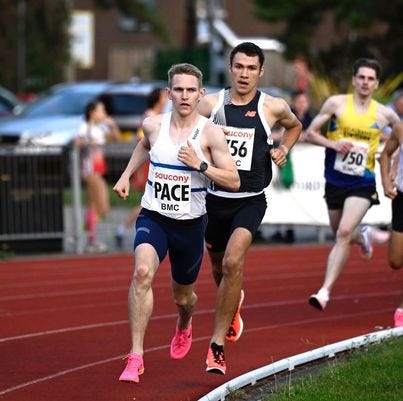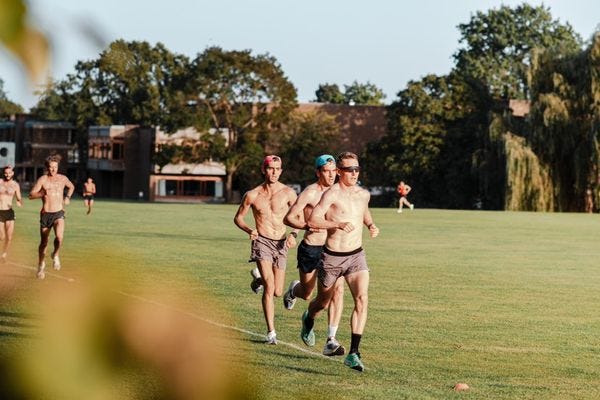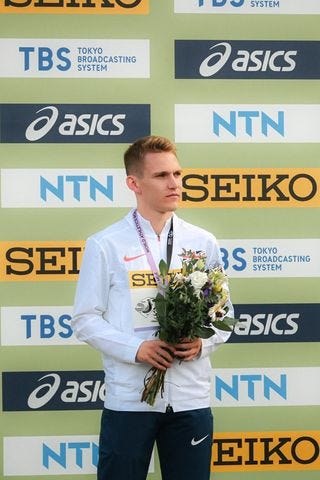Introduction
Callum Elson ran his first 1500 m in April 2022.
In 2023 he has represented GB twice, lowered his 1500 m PB to 3:35.39, and shown his competitive instincts with a mile PB where it matters most - with a Silver medal at the World Athletics Road Running Championships.
Callum was the perfect athlete to start this series. Most of the information I needed to write this post was already out there in some form, and he responded quickly when I asked if he’d be happy to talk about his training - ‘I’m all for it’.
You can follow Callum on Instagram, subscribe to his YouTube channel, listen to his Podcast, and follow his runs on Strava.
The training block we will dig into here is the nine weeks prior to the World Athletics Road Running Championships in Riga, Latvia.
About Callum
Coach: Nick Aguila
Sponsors: Soar Running
Running Background: Played football and ran recreationally until 2020. During COVID was when he decided to change his efforts toward running.
Outside of running: Freelance digital marketing.
Career Highlights:
2022 - NCAA DII Indoor Championships - 1 mi Champion
2022 - NCAA DII Championships - 1500 m Champion
2023 - UK Road Running Championships - Road Mile Champion
Personal Bests:
800 m - 1:49.87
1500 m - 3:35.39
Mile - 3:56.41
3000 m - 8:02.54 (indoor)
5000 m - 13:52.76
The Race
Event: World Athletics Road Running Championships
Location: Riga, Latvia
Result: 2nd, 3:56.41 (European Record)
Training Principles
I first wanted to know how the plan to target the World Road Running Championships came about. Callum told me that he had the race as an option when it was announced, but had to first run the qualification time.
“If we get under 3:37.5, we look at the road mile as an option. If I don’t get under it then it doesn't matter anyway. There's no point getting ready for it.”
Once Callum ran 3:36.21 in Italy in July, the plan could start to take shape. Taking another second off his 1500 m less than two weeks later made it an easier decision.
“Take a break now and then try and make a GB team or scramble around for some random races. You might get lucky with one. Maybe take off another half a second. It was a no brainer for me.”
Callum explained that he tries to keep open to different options when it comes to racing. Not knowing what races he might be able to get into, he has to be able to shift plans around to make the most of the opportunities which present themselves. The target is to run as fast as possible no matter which race he gets into.
Callum’s coach Nick Aguilas controls the performance aspects of his training, and Callum talked about the understanding they have about prioritizing long term progression. Having only taken running seriously since 2020, Callum described himself as a “24 year old junior” when talking about his training age.
With that in mind there is a moderation to Callum’s training which presumably gives him extra levers to pull in future years. A mindset where they believe Callum’s best results are not going to come for 3-4 years.
I asked about the priority of the training block: “strength” - meaning “not speed”. I got the impression that Callum and Nick viewed this as a lead into the winter base phase, rather than an extension of the summer track season.
That makes for an interesting balance in training - develop aerobic fitness, strength, but keep in touch with speed.
It makes sense when Callum described the challenge of the mile as a 100 m sprint after a 1500 m effort. If you aren’t in the position to use the speed then it doesn’t matter. Perhaps it is a little more important when shooting for a fast time on the track, but the road mile would be about racing.
The way this looked in training was:
A moderate volume of easy running - about 60-70 miles per week.
A mix of longer efforts - tempo’s, fartlek, and intervals - at paces from half marathon to 5 km effort.
Hills - short uphill intervals normally followed by some flat intervals; around mile effort.
A weekly long run - typically 13 miles at an easy effort.
In terms of how this is managed week to week, Callum talked about coordinating with Nick and the group at Cambridge and Coleridge. Sharing Nick’s plan with the coaches at the group and vice versa and trying to find a compromise between the two.
It was clear that Callum valued Nick’s insight on managing his training and particularly on determining what intensity to work at in the harder sessions. It was clear that there was a good deal of trust shared between the two of them. A relationship they forged when Nick coached Callum at college in the US.
It’s a case of ensuring that Callum understanding the purpose of each session and being disciplined with that. For instance, if he had been set 6 x 30 s but felt like 4 was enough then he could adapt based on how he felt during the workout. But if he was set 12 x 400 at 62 s and decided to run 6 faster efforts - getting carried away with the group perhaps - then that would be changing the purpose of the session. He wanted to be held to account on those aspects.
Callum talked about judging his efforts off feel, rather than heart race, pace, or lactate (although there would be more efforts in a summer track block where pace goals were important also). For instance, for the tempo runs he gave this rule of thumb:
“If you can’t do at least 50% more of what you’ve done, you’ve gone too hard. So when I finish a six mile, if I don’t think I could have held that for nine miles, then I’ve done a bit too hard.”
The confidence Callum built through the track season clearly extended into this block, but it was interesting to here how that confidence continued through without racing or running at race pace.
“In this particular build up I was doing far longer sessions, higher volume sessions. I was doing the laps of our road loop 10 seconds quicker than this time last year. … I’m in a good position and I can’t have lost much of the speed that I had two months ago.”
That sounds great in theory, but it also shows a good degree of control and a strong mindset. The World Road Running Championships was Callum’s first individual GB vest (having competed in two relays prior). I imagine there must have been a temptation to run some kind of race simulation or dedicated speed session when he was selected for the championships. It would be easy to wonder if you needed a little ‘extra’ for this occasion.
There was some specificity, with the hills and some short flat efforts at mile pace, but the focus remained on strength - with a confidence in knowing the aspects they were working on would be important in the longer term.
That respect for the long term progression was probably the main takeaway I had from talking to Callum.
“It’s the cliche thing that a B+ session is great. If it turns into an A star with the same effort, that’s great. But I’m not pushing to have two amazing workouts a week. I know that if I run consistent volume and I get two B+ sessions in each week and a decent long run. Then I'll naturally progress.”
That isn’t to say that there isn’t a lot of hard work involved in Callum’s training. There is. In this training block were some the longest training sessions Callum had ever done. But it seems to me like the goal was to work in a measured way, leaving room to progress and build into, rather than to accumulate as much hard work as possible.
Full Training Diary
Notes:
Two strength sessions most weeks. One heavier day and one lighter with more repetitions. One session on race weeks and no sessions on holiday.
Daily mobility and activation. 10-15 minutes before most runs.
Sports Massage every two weeks.
Week 1:
31/07/23: 1 h 21 m — 15.7 km (9.8 mi) — 39 m
Monday
Tuesday
Wednesday | 40 easy in 5:15 /km
Thursday
Friday | 40 easy in 5:09 /km
Saturday
Sunday
A complete rest after finishing the track season the previous week.
Week 2:
07/08/23: 6 h 32 m — 88.6 km (55.1 mi) — 268 m
Monday | 40 easy in 4:07 /km
Tuesday | 35 easy in 4:11 /km | 30 easy treadmill in 4:21 /km with 5 x 20 s hill strides
Wednesday | 50 easy in 4:11 /km
Thursday | 40 easy in 4:15 /km | 30 easy in 4:47 /km
Friday | 600 m in 1:30 (800 jog), 500 m in 1:14 (1200 jog), 400 in 57. 20 warm up, 15 cool down.
Saturday | 1h 40m long run - 22.5 km in 4:25/km
Sunday
Building back the training routine after the week off. Friday’s session was an anomaly as Callum agreed to help Louise Shanahan in her session before the World Athletics Championships. He said he wouldn’t suggest starting a new training block with a 57 s 400 m, but was happy to lend a hand.
Week 3:
14/08/23: 6 h 33 m — 93.9 km (58.3 mi) — 454 m
Monday | 55 easy in 4:13 /km
Tuesday | 5 mile tempo in 5:02 /mile 15 warm up, 15 cool down
Wednesday | 45 easy in 4:07 /km
Thursday | 50 easy in 4:13 /km
Friday | 2 x [2x 20, 2 x 40s] hills in 4:20 /mile (jog back), 5 x 30s flat in 3:55 /mile (30 s). 25 warm up, 15 cool down.
Saturday | 30 easy in 4:17 /km
Sunday | 1h 35m long run - 22.5 km in 4:12 /km
This is the first week where we see the rough outline of Callum’s training appear. Two sessions and a long run. Tuesday is the main “strength” workout. On Friday, hills to create some fatigue before faster efforts on the flat.
Week 4:
21/08/23: 7 h 24 m — 103.9 km (64.6 mi) — 488 m
Monday | 55 easy in 4:15 /km with 6 x 100 m strides
Tuesday | 40 easy in 4:14 /km | 40 easy in 5:04 /km
Wednesday | 800 in 1:54 + 3 x 1 mile in 5:19, 15, 12 (60 s) 20 warm up, 10 cool down
Thursday | 50 easy in 4:20 /km
Friday | 10 km Fartlek: 30, 60, 90, 120 s hard (equal float recovery). 20 warm up, 15 cool down
Saturday | 35 easy in 5:02 /km
Sunday | 1h 30m long run - 22.5 km in 4:05 /km. Last 6 miles moderate effort.
A slightly modified week to pace 800 m of the 1500 m BMC race on Wednesday. Friday’s fartlek is mainly strength focused with a mix of paces.
Week 5:
28/08/23: 8 h 17 m — 116.1 km (72.1 mi) — 435 m
Monday | 50 easy in 5:06 /km | 35 easy in 4:14 /km with 4 x 20 s strides
Tuesday | 25 easy in 4:23 /km | 6 miles tempo in 5:00 /mile, 5 x 100 m in 14-15 s (100 jog). 15 warm up, 20 cool down
Wednesday | 50 easy in 4:14 /km
Thursday | 40 easy in 4:17 /km | 30 easy in 4:12 /km
Friday | 9 x 40 s hills (jog back), 7 x 30 s flat (30 s). 20 warm up, 15 cool down
Saturday | 35 easy in 4:17 /km
Sunday | 1h 30m long run - 20.9 km in 4:18 /km
Similar sessions to two weeks previous, with small progressions. Callum talked about wanting the fatigue from these sessions to be at a similar level as the first efforts. Judging the effort off feel and not emptying the tank.
Week 6:
04/09/23: 7 h 04 m — 98.8 km (61.4 mi) — 381 m
Monday | 60 easy in 4:19 /km with 4 x 15 s strides
Tuesday | 6 x 3 in 3:00 /km (60 s), 6 x 30 s (60 s) at mile pace. 20 warm up, 15 cool down
Wednesday | 45 easy in 4:22 /km
Thursday | 30 easy in 4:16 /km with 4 x 15 s strides
Friday | 15 easy shakeout in 4:57 /km | Race: British Athletics Road Running Championships, 1 mile - 1st, 4:08. 20 warm up, 35 cool down
Saturday | 50 easy in 4:13 /km
Sunday | 1h 35m long run - 22.5 km in 4:14 /km
“Relieved that the plan end my track season a touch early paid off, and reap the rewards of some good training over the last few weeks. Perfect recipe of strength and speed from Nick Aguila.” - From Callum’s Instagram.
Week 7:
11/09/23: 7 h 21 m — 105.7 km (65.8 mi) — 1,283 m
Monday | 35 min in 3:49 /km with 4 miles in 5:45 /mile
Tuesday | 4 mile undulating tempo in 5:12 (4 min), 4 x 90 s in 4:40 /mile (60 s), 4 x 30 s in 4:30 /mile (30 s). 15 warm up, 10 warm down
Wednesday | 40 easy in 4:21 /km | 25 easy in 4:10 /km
Thursday | 40 easy in 4:25 /km with 4 x 15 s strides | 25 easy in 4:05 /km
Friday | 3 x [20, 40, 60, 80 s] + 2:30 hills (jog down) 15 warm up, 20 cool down (with 10 moderate)
Saturday | 35 easy in 4:05 /km | 30 easy in 5:01 /km
Sunday | 1h 20m long run - 19.3 km in 4:10 /km
Away on holiday - booked before aiming for the World Road Running Championships - the routine remained similar to previous weeks.
Week 8:
18/09/23: 8 h 00 m — 116.0 km (72.1 mi) — 495 m
Monday | 45 easy in 4:15 /km with 4 x 15 s strides
Tuesday | 15, 10, 5 tempo (3) in 4:47 /mi, 4:42 /mi, 4:33 /mi. 15 warm up, 15 cool down
Wednesday | 50 easy in 4:13 /km | 30 easy in 4:23 /km
Thursday | 55 easy in 4:19 /km with 4 x 20 s strides | 25 easy in 4:27 /km
Friday | 6 x 2 in ~4:48 /mi (3 in 5:25 /mi), 6 x 20 s hills (jog down). 20 warm up, 10 cool down
Saturday | 1h 35m long run - 22.5 km in 4:08 /km
Sunday | 45 easy in 4:28 /km
Two weeks before the race. There is a nod to sharpening, with the tempo paces coming down a little, but no big changes. There is no shift to include any last minute speed sessions. Callum and Nick stuck with the plan.
Week 9:
25/09/23: 6 h 54 m — 97.5 km (60.5 mi) — 258 m
Monday | 5 mile sub-threshold (5:35 /mile) + 4 x 15 s strides | 30 min easy - 4:09 /km
Tuesday | 25 easy - 4:16 /km | 4 x 5 tempo in 4:30 /mi (2:15), 90, 60, 30s at mile pace. 15 warm up, 15 cool down
Wednesday | 60 easy - 4:36 /km
Thursday | 50 easy - 4:16 /km with 6 x 20s (40s) strides
Friday | 55 easy - 4:23 /km
Saturday | 30 easy - 4:43 /km with 3 x 20s, 2 x 10s strides
Sunday | 10 easy shakeout - 4:52 /km | Race: World Athletics Road Running Championships, 1 Mile - 2nd, 3:56.41 (European Record) 20 warm up, 30 cool down |
Race week. Watch this excellent YouTube video if you want to understand how the race unfolded. But clearly, the race went well.
I hope you found this article as interesting as I found writing it. I believe there is a lot to learn from seeing how others train. The same training won’t have the same effect on different people, but learning from other people can help us see how the problem of improving as a runner can be addressed in different ways.
I also think there is a value to seeing what training looks like in detail - more than a ‘typical week’. Plans change, things don’t work as expected, and sometimes you need to adapt - that’s all a part of training. No two weeks look exactly the same. Hopefully, we can better understand why.
If you are a coach or athlete and want to collaborate on an article like this - please reach out. I’m always interested to talk to people with different approaches and different experiences.





This is awesome 👌
Thanks for the inside look. It's really interesting to see how a professional looks at training.